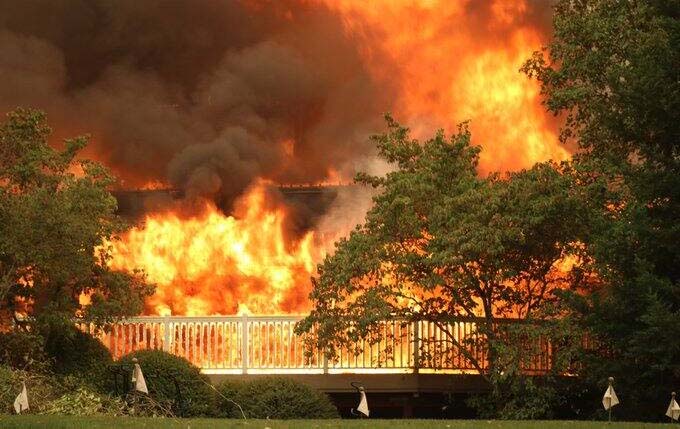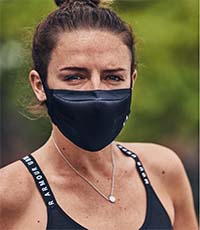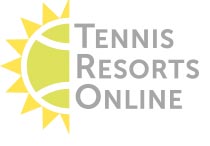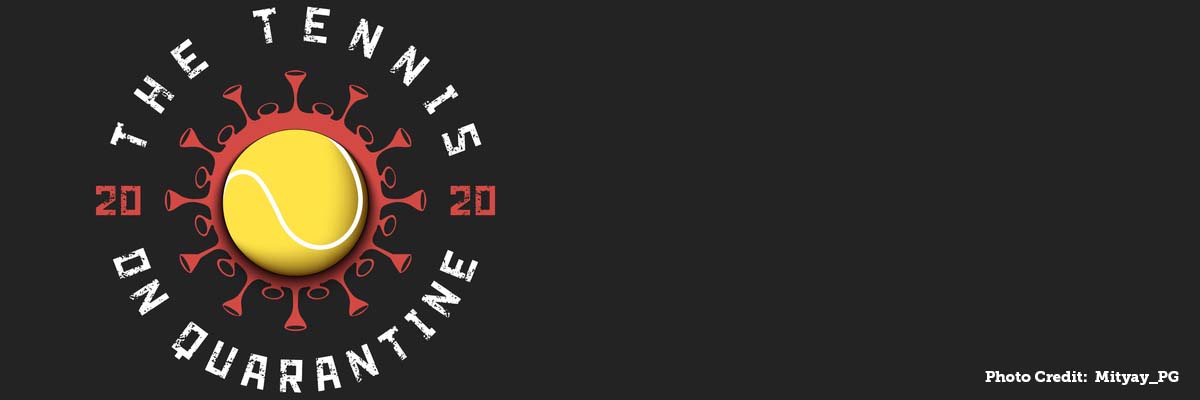Tennis In the Time Of the Coronavirus
When a hurricane strikes the Caribbean or parts of the U.S., it's painful to report about the affected areas but usually fairly straightforward to list the tennis resorts that suffered damage and outline their timetable for recovery. The coronavirus, by contrast, has brought devastation of an entirely different kind, one that affected not just a geographic region but the world. The pandemic didn't damage places; it targeted people, and unlike a hurricane that eventually blows itself out, the coronavirus has lingered, drawing renewed strength each time it finds another cluster of vulnerable people.
To deprive it of hosts, the country largely shut down, and for the tennis community that has meant a cancellation of major tournaments—the BNP Paribas Open, the Miami Open, and Wimbledon among them. It pushed the French Open into the fall calendar and emptied the U.S. Open venue of fans and its draws of last year's champions. Its effects have been felt all the way down to the grassroots, as state-ordered lockdowns banned play on many public tennis courts and forced indoor clubs to shutter their doors. Junior tennis camps that normally take place on college campuses or private schools in summer likewise became casualties of the virus. Most—though not all—tennis resorts and camps went on hiatus (sadly, Meadowood Napa Valley's restaurant and other structures were destroyed not but the virus but by one of 40+ fires burning in California. See Tennis Resort and Camp News. Some states imposed mandatory quarantines for visitors from outside their boundaries (Vermont, for example, has a map, updated weekly, showing which visitors must quarantine based on their county of residence, and through October 14, Hawaii requires all visitors to self-quarantine for 14 days upon arrival). Canada closed its border to U.S. residents, as did countries in Europe and some islands in the Caribbean. International travel became almost unthinkable. And as if all of that weren't bad enough, there are now air-quality alerts from the western wildfires in parts of California and Oregon. It has been a rough several months. Those who'd made tennis vacation plans had to cancel or postpone them; those who hadn't longed for the joy and release a tennis holiday affords while wondering when they'd feel safe enough to travel again and what that holiday would be like in an era of face masks, social distancing, and obsessive hand-washing.
Pent-up Demand
And yet, so strong is the urge to get back on the court that recreational players have already begun to adapt to the new reality. Some resorts never shut down, and other have—sometimes tentatively—begun to open back up. And while I can't give you a complete list of who's open and who's not, I do want to provide a collage that reflects the varied state of the tennis resort and camp landscape in the age of the coronavirus.
![]() The Resort at Longboat Key Club is among the lucky ones that never had to shut down. Their tennis business necessarily tailed off, only to rebound in the face of what tennis director Briana Harris Francois describes as "an enormous pent-up demand" leading to an even better summer than last year. Situated on the island of Longboat Key on Florida's Gulf Coast, the club has lately experienced a flood of tennis-deprived members and visitors, the latter mostly from elsewhere in Florida. The majority arrive by car, eager to get back to some semblance of tennis normalcy, even if it means donning face masks in public areas, bringing their own water and towels, and showering when they get back to their room. The Greenbrier in West Virginia not only did not shut down but even staged two weeks of World Team Tennis matches—with spectators—keeping players in a bubble and otherwise relying on its relative isolation and regionally low rate of COVID infections.
The Resort at Longboat Key Club is among the lucky ones that never had to shut down. Their tennis business necessarily tailed off, only to rebound in the face of what tennis director Briana Harris Francois describes as "an enormous pent-up demand" leading to an even better summer than last year. Situated on the island of Longboat Key on Florida's Gulf Coast, the club has lately experienced a flood of tennis-deprived members and visitors, the latter mostly from elsewhere in Florida. The majority arrive by car, eager to get back to some semblance of tennis normalcy, even if it means donning face masks in public areas, bringing their own water and towels, and showering when they get back to their room. The Greenbrier in West Virginia not only did not shut down but even staged two weeks of World Team Tennis matches—with spectators—keeping players in a bubble and otherwise relying on its relative isolation and regionally low rate of COVID infections.
![]() The hotel at Horseshoe Bay Resort, an hour north of Austin, TX did close during the early days of the coronavirus and tennis director Michelle Stallard had to cancel her spring tennis and wine camps and summer junior camps, though she was able to continue to offer clinics and private lessons and opportunities to play. "We were very fortunate that Llano county area did not have as many cases as the big cities." she told me. Now her tennis and wine weekends are back on the calendar, scheduled for October. The one wrinkle: she says she may have to do the wine tasting on site, since for the moment the wineries remain closed.
The hotel at Horseshoe Bay Resort, an hour north of Austin, TX did close during the early days of the coronavirus and tennis director Michelle Stallard had to cancel her spring tennis and wine camps and summer junior camps, though she was able to continue to offer clinics and private lessons and opportunities to play. "We were very fortunate that Llano county area did not have as many cases as the big cities." she told me. Now her tennis and wine weekends are back on the calendar, scheduled for October. The one wrinkle: she says she may have to do the wine tasting on site, since for the moment the wineries remain closed.
![]() As Stallard points out, and the Greenbrier found, it helps to be distant from major population centers. That's also true of Waterville Valley Resort in New Hampshire. Its 18 red-clay tennis courts opened as usual in May, although director Tom Gross had trepidations about what the season would bring. Instead, he has had what he describes as an "explosive" summer, with an unprecedented demand for adult and junior clinics, including those offered by New England Tennis Holidays (which relocated their camps to Waterville when Sugarbush in Vermont decided not to resurface their outdoor courts). He ran a full slate of programs, including round robins, tournaments, men's nights, women's doubles league practices, and mixed doubles socials. They required masks in public areas and made hand sanitizer ubiquitous, but it was otherwise a normal—if unusually busy—summer.
As Stallard points out, and the Greenbrier found, it helps to be distant from major population centers. That's also true of Waterville Valley Resort in New Hampshire. Its 18 red-clay tennis courts opened as usual in May, although director Tom Gross had trepidations about what the season would bring. Instead, he has had what he describes as an "explosive" summer, with an unprecedented demand for adult and junior clinics, including those offered by New England Tennis Holidays (which relocated their camps to Waterville when Sugarbush in Vermont decided not to resurface their outdoor courts). He ran a full slate of programs, including round robins, tournaments, men's nights, women's doubles league practices, and mixed doubles socials. They required masks in public areas and made hand sanitizer ubiquitous, but it was otherwise a normal—if unusually busy—summer.
![]() In South Carolina, Kiawah Island Golf Resort's experience was probably more typical. The resort, including the tennis center, closed from early April to mid May. Once tennis got the green light, it slowly reopened, first with small numbers of players, who checked in on the deck of the pro shop (which remained closed). By mid August, the tennis situation had improved to the point of allowing up to five customers in the pro shop and giving staff the confidence to once again stage tournaments, including one for 159 juniors. Pickleball and limited tennis programs returned about the same time. Says director Jonathan Barth of the ordeal: "It's been a challenging situation for us," but circumstances are improving well enough that he feels confident in staging tennis weekends late October and November.
In South Carolina, Kiawah Island Golf Resort's experience was probably more typical. The resort, including the tennis center, closed from early April to mid May. Once tennis got the green light, it slowly reopened, first with small numbers of players, who checked in on the deck of the pro shop (which remained closed). By mid August, the tennis situation had improved to the point of allowing up to five customers in the pro shop and giving staff the confidence to once again stage tournaments, including one for 159 juniors. Pickleball and limited tennis programs returned about the same time. Says director Jonathan Barth of the ordeal: "It's been a challenging situation for us," but circumstances are improving well enough that he feels confident in staging tennis weekends late October and November.
![]() The historic Broadmoor, in Colorado Springs, CO endured a much longer delay before once again accepting guests. A statewide shelter-in-place order closed the resort in mid March and it wasn't able to reopen until late June. When it did, the tennis thrived. "There was a pent-up demand not just for tennis but for retail as well," tennis director Karen Schott told me. "Our shop did well because people felt confident about buying." And though there was demand for tennis, there was also circumspection. "People wanted to stay with their tribe," she continued, "so we did a lot of family oriented drills, private camps for USTA teams, and semi-private lessons for couples." But there was also a simple joy in returning to playing tennis. "People were just thrilled to get back on the court. It reminded me of the enthusiasm for tennis in the 1970s."
The historic Broadmoor, in Colorado Springs, CO endured a much longer delay before once again accepting guests. A statewide shelter-in-place order closed the resort in mid March and it wasn't able to reopen until late June. When it did, the tennis thrived. "There was a pent-up demand not just for tennis but for retail as well," tennis director Karen Schott told me. "Our shop did well because people felt confident about buying." And though there was demand for tennis, there was also circumspection. "People wanted to stay with their tribe," she continued, "so we did a lot of family oriented drills, private camps for USTA teams, and semi-private lessons for couples." But there was also a simple joy in returning to playing tennis. "People were just thrilled to get back on the court. It reminded me of the enthusiasm for tennis in the 1970s."
![]() Masks aside, tennis allowed players to feel a sense of normalcy. That's what Oakley Fox points to to explain the huge turnouts he's getting for his Racquet War weekend tournament getaways. "After I had to cancel events in the spring, people kept contacting me, saying 'We're ready.'" Once Omni Amelia Island Resort reopened, his event there drew 256 participants, and he already has more than 300 signed up for one in September. He had to make some logistical changes in light of the coronavirus: people received court assignments via a text message and rather than post the draw on a big board—which would encourage a crowd to gather—he made it available online. Players also had to bring their own water, cups, and chairs, though there was a big jug of Gatorade—with an adjacent bottle of hand sanitizer to use before and after pushing the spigot button. When it came to masks, he said "We're treating them as adults, and they should do what they're comfortable with." He felt safe adopting that approach, adding "Being outside is the key."
Masks aside, tennis allowed players to feel a sense of normalcy. That's what Oakley Fox points to to explain the huge turnouts he's getting for his Racquet War weekend tournament getaways. "After I had to cancel events in the spring, people kept contacting me, saying 'We're ready.'" Once Omni Amelia Island Resort reopened, his event there drew 256 participants, and he already has more than 300 signed up for one in September. He had to make some logistical changes in light of the coronavirus: people received court assignments via a text message and rather than post the draw on a big board—which would encourage a crowd to gather—he made it available online. Players also had to bring their own water, cups, and chairs, though there was a big jug of Gatorade—with an adjacent bottle of hand sanitizer to use before and after pushing the spigot button. When it came to masks, he said "We're treating them as adults, and they should do what they're comfortable with." He felt safe adopting that approach, adding "Being outside is the key."
Ch-ch-ch Changes
Elsewhere, however, the road back has been slower and sometimes fraught with challenges. IMG Academy in Bradenton, FL reopened in midsummer but has had to make several adjustments to its programming. They capped their year-round junior camp enrollment at 150 (down from the usual 250) and after running weekly camps during the summer, canceled all of them for the fall (though year-end holiday camps remain on the schedule). Their adult camps are operating as usual; however, lodging at the Legacy Hotel on campus will not be available until early October, since the hotel currently serves as the bubble for the WNBA. For the renowned gathering of tennis legends for the Tennis Fantasies event in October at the John Newcombe Tennis Ranch in Texas the issue was not lodging but the need maintain safety protocols, which required reducing the number of participants from the usual 90+ to 40. John Newcombe himself won't be able to take part since he's stuck in Australia but players can look forward to taking to the court with, among others, Mark Woodforde. Johan Kriek, Rick Leach, and Luke Jensen.
![]() Every hotel, resort, and camp has had to adopt new standards of cleaning, disinfecting, and staff hygiene. Most resort restaurants, forced by regulations to limit their indoor dining, have adopted the same survival tactics as those in major cities like New York, setting up tables out of doors and offering take out. Self-service buffets like those at Newk's Ranch and Total Tennis have moved behind Plexiglas, where staff fills plates as guests point to their choices. Social-distancing rules may also require you to make reservations for the resort's swimming pools and limit your access to spas and fitness centers. Resorts and camps desperately want you back and are doing everything they can to make you feel safe and to keep you safe, on court and off.
Every hotel, resort, and camp has had to adopt new standards of cleaning, disinfecting, and staff hygiene. Most resort restaurants, forced by regulations to limit their indoor dining, have adopted the same survival tactics as those in major cities like New York, setting up tables out of doors and offering take out. Self-service buffets like those at Newk's Ranch and Total Tennis have moved behind Plexiglas, where staff fills plates as guests point to their choices. Social-distancing rules may also require you to make reservations for the resort's swimming pools and limit your access to spas and fitness centers. Resorts and camps desperately want you back and are doing everything they can to make you feel safe and to keep you safe, on court and off.
An Uncertain Autumn
Whether that's enough is your decision, of course. Whatever your intentions, they may well be altered if, as some predict, there is a resurgence of the coronavirus as we head into the traditional fall flu season. Meanwhile, we are all facing a fragmented vacation landscape comprised of resorts and camps that are variously open, open with reduced amenities and programs, open with an asterisk (like Vermont), just now reopening (like properties in Phoenix and Palm Springs), or not yet open (like California's Park Hyatt Aviara Resort). Inevitably there have been staff changes as well. Milan Kubala has moved on from directing the tennis operation at Topnotch Resort & Spa in Vermont (though his longtime assistant Shaun Zemanek remains) and Chad Ruthig no longer teaches at the Westin Mission Hills Resort & Spa in Rancho Mirage, CA after the resort ended its partnership with Peter Burwash International. So if you are determined to travel, I have two pieces of advice: check the resort or camp's website (you'll find a list of those we cover with links at Tennis Resorts Online); and phone the tennis center to see what specific programs and services will be available during the days you want to visit. Then add face masks and hand sanitizer to your racquet bag and you're ready to go. When you get back, be sure to review your experience at Rate a Resort or Camp.
Tennis Resort/Camp News

Fire Destroys Meadowood Napa Valley
The raging Glass fire in California's Napa Valley swept through the hills west of St. Helena and destroyed the Michelin-starred restaurant and several other structures. As recently as Sunday, September 28, the resort did not seem to be in immediate danger, with the fire burning east of the Silverado Trail. But with a shift in the wind, the fire jumped the trail and rage into the mountains to the west of St. Helena and up the valley containing the resort, local Press Democrat reports. Fortunately, there are no reports of loss of life there; however, some 5,000 residents of Calistoga had to evacuate. As other details emerge, I'll post them here.
Drysdale Tennis Adds To Portfolio

Cliff Drysdale Tennis has contracted to manage two additional properties: the Ritz-Carlton, Bacara (pictured above) in Santa Barbara, CA and the Mauna& Lani, Auberge Collection Resort on Hawaii's Big Island. Bacara perches atop a bluff overlooking two miles of beach, a little north of Santa Barbara. Architecturally it resembles a Spanish Colonial village, as winding pathways connect low-slung buildings with open balconies and courtyards with fountains. Within its 78 acres are 311 rooms and suites, a 42,000-square-foot spa, a fitness center, 3 rimless swimming pools, and four Har-Tru tennis courts. Its connection to a 1,000-acre lemon and avocado ranch adds more dimensions, like horseback riding, hiking and mountain biking. Golfers, meanwhile, have privileges at local courses. Drysdale's Luis Vallecillo runs the programs, having most recently directed the junior programs at the Omni Amelia Island Resort.
![]() Mauna Lani debuted as an Auberge Collection Resort in January of this year following a $200 million "reimagination." Set on 32 acres of the Kohala Coast on Hawaii's Big Island, the hotel has long been notable for a seaside location that includes Kalāhuipua'a Historic Park, a sacred place of petroglyphs, royal fishponds, and lava caves. It has 332 rooms and suites as well a five two-bedroom bungalows with private pool and concierge. Other amenities include three restaurants, a beach shack, mini-market, a spa and fitness center, a six-court Cliff Drysdale Tennis Center, two 18-hole and one 9-hole golf course,a water sports center, a kids' island hideaway, and a cultural center, the last a mini-museum offering guided cultural walks, entertainment, and workshops in lei making, lauhala weaving, mo'olelo story telling, and stargazing. The Drysdale group appointed Matt Matt Dudley, the former Adult Program Director at the California's Omni La Costa Resort & Spa, to run the tennis operation. All of his programs, including cardio tennis and pickleball, are open to hotel guests, members, and the general public. (Hawaii opens with some restrictions, including a negative COVID test, on Oct. 15.)
Mauna Lani debuted as an Auberge Collection Resort in January of this year following a $200 million "reimagination." Set on 32 acres of the Kohala Coast on Hawaii's Big Island, the hotel has long been notable for a seaside location that includes Kalāhuipua'a Historic Park, a sacred place of petroglyphs, royal fishponds, and lava caves. It has 332 rooms and suites as well a five two-bedroom bungalows with private pool and concierge. Other amenities include three restaurants, a beach shack, mini-market, a spa and fitness center, a six-court Cliff Drysdale Tennis Center, two 18-hole and one 9-hole golf course,a water sports center, a kids' island hideaway, and a cultural center, the last a mini-museum offering guided cultural walks, entertainment, and workshops in lei making, lauhala weaving, mo'olelo story telling, and stargazing. The Drysdale group appointed Matt Matt Dudley, the former Adult Program Director at the California's Omni La Costa Resort & Spa, to run the tennis operation. All of his programs, including cardio tennis and pickleball, are open to hotel guests, members, and the general public. (Hawaii opens with some restrictions, including a negative COVID test, on Oct. 15.)
Tennis Resort/Camp News

Fire Destroys Meadowood Napa Valley
The raging Glass fire in California's Napa Valley swept through the hills west of St. Helena and destroyed the Michelin-starred restaurant and several other structures. As recently as Sunday, September 28, the resort did not seem to be in immediate danger, with the fire burning east of the Silverado Trail. But with a shift in the wind, the fire jumped the trail and rage into the mountains to the west of St. Helena and up the valley containing the resort, local Press Democrat reports. Fortunately, there are no reports of loss of life there; however, some 5,000 residents of Calistoga had to evacuate. As other details emerge, I'll post them here.
NeuroTennis By Mats Wilander

Former world No. 1 and 8-time Grand Slam singles winner Mats Wilander has developed a wearable wrist band called NeuroTennis that provides coaching instructions as you play. Those instructions are synchronized with the rhythm of your playing, which, the website says "conditions your brain to develop the best skills and habits." Like so much these days, the band is controlled by an app on your smartphone. From there, you can select and customize lessons and drills from an extensive library designed by our world-class coaches, including Mats Wilander. Unlike other wearable devices that may measure the speed and spin of your ball, or the number of various strokes you hit, Neuro Tennis is designed to help you develop professional-level focus. The intent, says Wilander, is "to modify your game not just measure it." He continues, "I believe that to reach your full potential, you need to train your brain just as hard as your skills and fitness." The website shows how it all works.

Sports Mask-erade
Need a mask for getting to and from the tennis court? Under Armour has you covered, so to speak. Designed to be worn while playing sports, theirs are constructed from layers of washable fabric—the inner one antimicrobial, the outer waterproof—with a bendable nose bridge and SPF 50+ sun protection. Polyurethane open-cell foam middle layer lets air in but makes it hard for moisture and sweat to pass through. A detailed size chart aids in choosing one with the best fit. The cost: $30. Rafa Nadal has also come out with a mask for his academy, priced at €12.90. Not to miss out, adidas, and Reebok also make masks; however, theirs are currently sold out.
A Roomba For Tennis Balls

Forget ball hoppers and tennis tubes, Tennibot™ cruises around the court using artificial intelligence and computer vision to gather up all the tennis balls, thus giving you an estimated 20 percent more hitting time. It comes with an app that allows you to program it to pick up everything on both sides of the net, one side only, or only those at the net. And it keeps track of how many it's picked up so you know how many you've hit. See it in action here.
Packages and Specials
Adult Tennis Camps
- John Newcombe Tennis Ranch, Texas: Save $100 on any all-inclusive adult package
Packages and Specials
Adult Tennis Camps
- John Newcombe Tennis Ranch, Texas: Save $100 on any all-inclusive adult package



